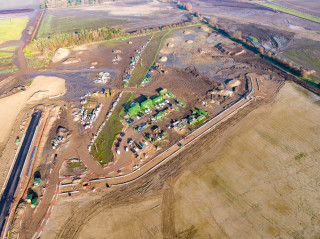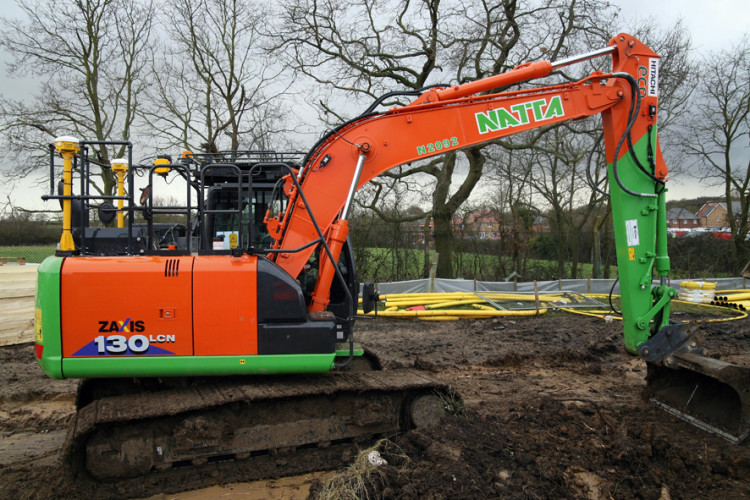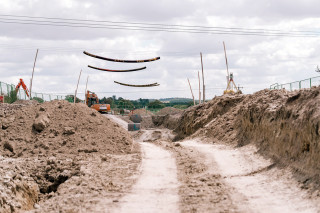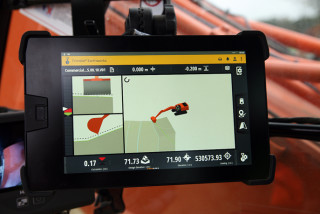The post-recessionary boom in house-building has proved a godsend to the nation’s earthmoving contractors. And despite signs of a slowdown, mostly centred on the London market, it continues to provide a healthy workload for muckshifting specialists.
Most of the ‘muck’ being shifted on developer St Modwen’s Kingsgrove development at Crab Hill, near Wantage in Oxfordshire, isn’t muck at all, but high-quality agricultural topsoil.
“Apart from one very localised contamination ‘hotspot’ the site is all greenfield agricultural land that’s been farmed for hundreds of years,” says the firm’s construction manager Tim Jones.
And it’s this vast amount of high-quality topsoil that provides the biggest challenge from an earthmoving perspective. “Topsoil can’t be used for engineering purposes, so it all has to be removed,” says Jones.
The topsoil extends to a depth of about 600mm but averages about 300mm across the 227-acre site where 1,500 new homes, a primary school and community facilities are to be built.
The site is being developed in phases, with St Modwen delivering up to 50% and the remaining residential land being sold to third-party house-builders.
The daunting task of shifting all that topsoil and preparing the ground for the development is being undertaken by earthmoving specialist Natta Building.
Natta’s £7m contract is for the first two phases and covers all the earthworks and infrastructure, including drainage and all the Section 278 works (roads, pavements and kerbs).
The topsoil is being stripped and relocated as work progresses. Some of it is being used to landscape a 30-acre community woodland located along the site’s north-eastern flank.
“We have an obligation to do early woodland planting as part of the planning permission,” explains Jones. “That means that we have to move a lot of earth early on to landscape the wooded areas and get the levels right.” St Modwen has already planted 10 acres of young trees for the new woodland.
Topsoil that is not required for the new woodland is temporarily stockpiled in accordance with St Modwen’s C:LAIRE code of practice materials management plan at a location in the middle of the site. This will be used to create the front and back gardens as the houses take shape.
None of the material excavated on site will be disposed of off-site, says Jones; the intention is to reuse everything for landscaping or fill.
Once the topsoil has been stripped away, Natta has to level the site and prepare the ground for the building to start. This involves excavating and relocating some of the earth to create suitably level plateaus on which to build. Much of this material has been taken from a large cutting dug into the ground at the western end of the site (below).
Here, a new link road is being built and the 100m-long cutting is required to level the gradient along the route. “All that material is being reused elsewhere on site; there’s a big east-west movement of material,” says Jones. He says that approximately 90,000m3 of material is being removed from the cutting and reused.

The subsoil is a firm sandy clay and easy to work with, says Natta’s technical director Huw Rees. The company has set up a laboratory on site to test soil samples and ensure its suitability. “The CBR [bearing capacity] of the soil has to be at least 5% and so far the material has met that requirement and we haven’t had to use any soil-improvement methods,” says Rees.
Last year’s dry weather allowed work to progress quickly, he adds, but it brought an unexpected problem: “In fact, last summer was so hot and dry that we actually had to
add water to the excavated soil because, without it, it couldn’t be compacted sufficiently.

“Now, the weather’s much wetter and we’re getting to the point where we might have to consider lime stabilisation to get the right stiffness,” he adds.
At the time of writing, Natta’s earthmoving contract was about 80% complete, with less than 30,000m3 to go. But what Rees is most keen to talk about is the technology he is using to carry out the work. “The biggest thing for us about this contract is Trimble Earthworks,” he says.
In the past six months Natta has spent over £500,000 on equipping its earthmoving fleet with Trimble’s latest grade control system and now claims to have the largest Trimble-equipped earthmoving fleet in the UK (see box).
St Modwen’s Kingsgrove development is Natta’s first major outing with the technology and Rees says the results are exceeding expectations. “We’re seeing a 15 – 20% improvement in efficiency,” he says. With all excavation parameters relayed to each machine from a central base station on site, each operator only has to climb into the cab, log in via the touchscreen display and start digging.
“The operator doesn’t have to wait for anybody else, like an engineer or a surveyor. The Trimble system tells him exactly what to do and records what he’s done,” says Rees.
Key to the success of the system is its ease of use, he adds. “We looked other systems and took our operators along to try them out but we got the best feedback from the Trimble system. It’s clear, accurate and our operators found it to be the most user-friendly,” says Rees.
Natta is now finishing its second phase works which it will hand over to Cala Homes, the first third-party house-builder on the project, in May. There are more phases – about nine in total – to go before the entire development is completed, in about 10 years’ time.
Rees is hopeful that Natta will be working on the Kingsgrove development for several years to come.
Trimble Earthworks
Natta Building claims to hold the biggest Trimble Earthworks fleet in UK, with 22 excavators and one dozer equipped so far.
The Trimble Earthworks Grade Control platform employs intuitive, easy-to-learn software that runs on an Android operating system and gives operators of all skill levels the ability to work faster and more productively than before.
Trimble Earthworks is an integrated system combining specialised hardware and software. The hardware component comprises two global navigation satellite (GNSS) rovers which are connected to an on-site base station with a working range of two miles.
The software component runs on a 10-inch tablet computer mounted inside the excavator’s cab. It displays three-dimensional information to the driver.
Natta says that this technology is increasing the rate of production on bulk excavations, road construction and foundations, saving engineers valuable time in setting out. And it calculates that a 40% improvement in efficiency is achievable.
This article was first published in the February 2019 issue of The Construction Index magazine
UK readers can have their own copy of the magazine, in real paper, posted through their letterbox each month by taking out an annual subscription for just £50 a year. Click for details.
Got a story? Email news@theconstructionindex.co.uk





